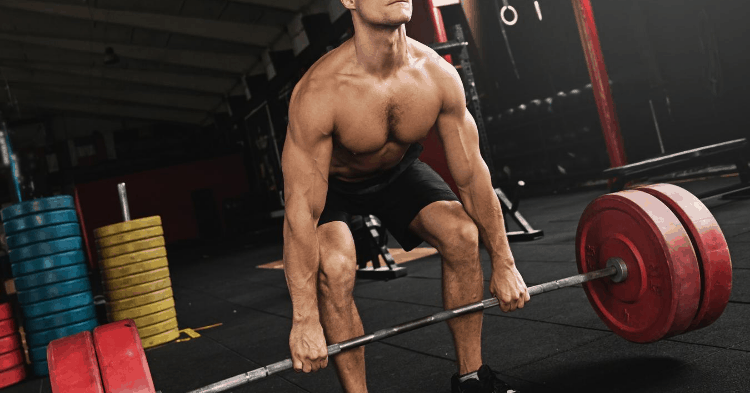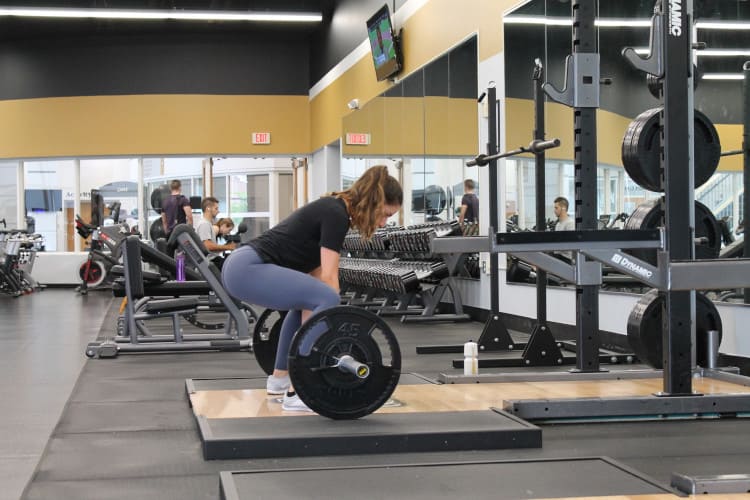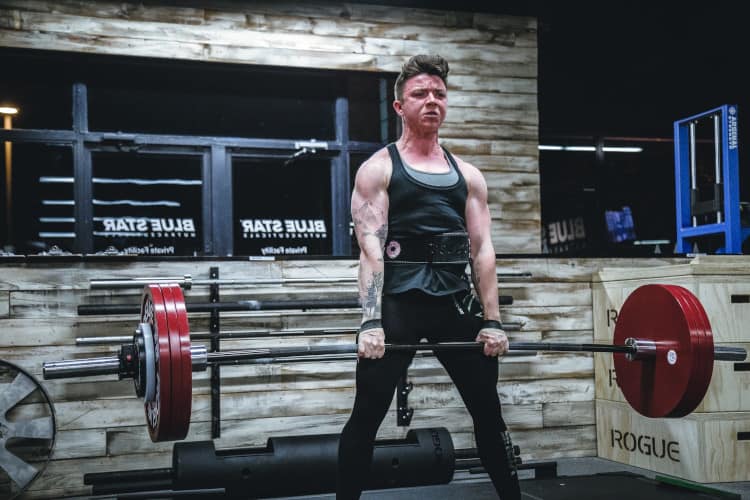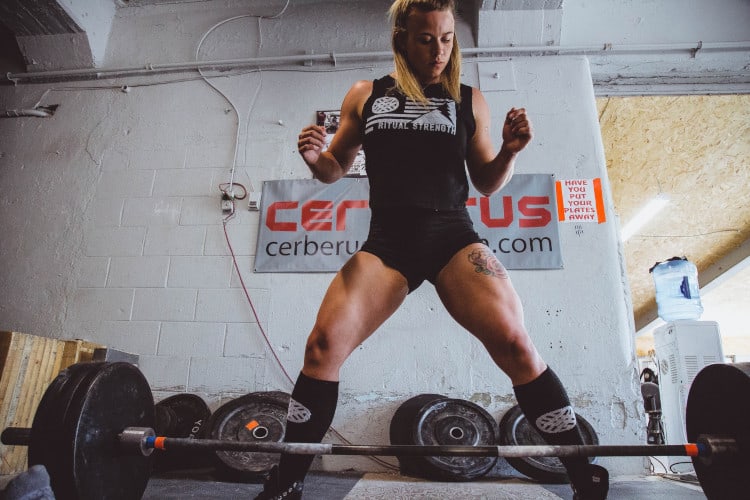Whether you should deadlift on back or leg day depends on three major considerations. You should consider what you do on back day, leg day, and when you should deadlift during your workout general routine. Deadlifts are a powerful exercise that helps you build muscle mass, strength, and explosive power. The fundamental strength training exercise engages various muscle groups and offers numerous adaptations for lifters of all levels. It’s important to incorporate deadlifting appropriating or risk injury and strain.

Deadlifting on back or leg day is ultimately a matter of your workout routine and goals. There’s understandably a lot of confusion about whether you should deadlift on back or leg day. Today, we’ll go over what you need to know about deadlifts and the best way to work them into your training.
Contents
What muscles do deadlifts work?
Deadlifts are a compound movement that work the body’s major muscle groups, including your glute muscles, hamstrings, quads, core muscles, lats, rhomboids, and traps. Furthermore, deadlifts help lifters improve grip strength, a key biomarker of healthy aging, and muscle-loss prevention.
The fact that deadlifts engage both the leg and back muscles is where the confusion surrounding their purpose originates. While this compound movement is one of the best full-body exercises, your glutes and hamstrings are the primary movers in a traditional deadlift. Even when you use a deadlift variation, such as the sumo deadlift, the legs and lower posterior chain are doing most of the work.
Does this mean that deadlifts should be a leg day workout? Not necessarily— there are varying influencing factors to consider.
Should I do deadlifts on leg day?

When you perform a barbell deadlift, the initial force comes from the legs. Your hamstrings and glutes flick on, your glutes tighten, and the barbell starts to move away from the floor. While a deadlift is considered a pull exercise, those first few seconds can feel like you’re pushing yourself away from the floor using your legs.
As the legs are the primary mover, deadlifts are often grouped with leg day workouts. However, there are a few primary considerations when choosing this path.
First, you need to consider your timing. If you’re doing an intense leg day workout with barbell squats, it’s best to time deadlifts toward the end of your workout. One of the reasons why this movement is so powerful and considered the king of strength training is that you’re lifting dead weight with no momentum with your entire body. As a result, you should be pretty tired after deadlifting. If you start leg day with deadlifts, you’ll likely derail the rest of your workout, which is why deadlifts are the last event in a powerlifting competition.
Another reason to do squats first is that they act as a fantastic warm-up for deadlifts. The hip hinge motion and posterior chain engagement are a fantastic stepping stone toward deadlifts. Some competitive powerlifters only train squats during the offseason, as they know the muscle gains will translate to deadlifts later on.
However, there’s a downside to doing deadlifts after a leg workout as well. You could lack the energy after an intense squat workout to do heavy deadlifts. If your goal is to increase your deadlift PR, this could present a challenge.
Read more: Can You Squat and Deadlift On the Same Day?
Should I do deadlifts on back day?

As the barbell gets higher during the deadlift movement, your back takes over. Your lower back works with your hip muscles to get that hinge motion and strong lockout. Your upper back pulls the bar to full extension. While your back muscles may not be the primary mover, there’s no argument that they play an integral role in this exercise.
The engagement of the lower back, lats, and traps are why some lifters incorporate deadlifts on back day. As you aren’t at risk of tiring out your legs during an intense lower body workout, you can complete heavier deadlifts as a part of an upper-body routine. Depending on your goals, you could put deadlifts at the start of the workout, and complete targeted back accessory lifts after.
Deadlifts also work well when done in conjunction with bench pressing. In particular, many powerlifters enjoy that they can perform heavy deadlifts and bench pressing on the same day. Deadlifts always follow bench pressing in competitions, with Push-Pull (also known as Iron Man) competitions eliminating squats entirely.
While deadlifting does build core and muscular strength, it’s limited in terms of building muscle mass. Deadlifts alone won’t get you the massive, shredded back muscles you desire.
When should I do deadlifts?

Choosing when to do deadlifts ultimately depends on your training goals and regimen. In addition to deciding whether you should deadlift on back or leg day, consider the third option: deadlifting on deadlift day.
For bodybuilders and general fitness enthusiasts, the muscle group split on different training days is useful. For powerlifters, having a focused deadlift day may prove more valuable.
Here are some things to consider when deciding to continue working by muscle group or shifting the focus to the big three lifts.
What are your lifting goals?
Everyone has their reasons for hitting the gym. Take some time to look inward and explore your motivations. If your goal is to build muscular strength or compete as a powerlifter, your barbell deadlift workouts take priority over accessory work. In this case, you might decide to deadlift on both back and leg day, choosing high reps and low weight on leg day, and low reps and heavy weight on back day.
Some powerlifting training modalities take a different approach by designating a focused day for deads. On this day, heavy deadlifts are the primary focus with complementary accessory lifts after the fact. The rest of the weekly training schedule incorporates focused days for squats and bench.
If your goal is to build a shredded physique, the deadlift isn’t going to be the top priority for back day. It’s better suited on leg day as an accessory movement. Heavy deads are still worth working into the routine on back day, as the boost in core strength and posterior chain health play a valuable role in training.
Deadlift styles and variations
The deadlift is a versatile exercise with different styles and variations to choose from. Instead of focusing on a conventional deadlift, you can incorporate a deadlift variation into your training on different days. This approach is perfect for improving form and perfecting the hip hinge motion without overtaxing the body with multiple deadlift days.
Some common deadlift variations include the following.
Sumo deadlift
The sumo deadlift is an alternative to the conventional deadlift that serves as an acceptable variation in competitions. Sumo lifters take a wide stance with their feet planted outside of shoulder width. The sumo deadlift shifts some of the focus from the hamstring to the quad.
Trap bar deadlift
The trap bar deadlift (also known as the hex bar deadlift) is a deadlift variation that uses a hexagonal bar with perpendicular handles. The trap bar deadlift reduces the range of motion and the lumbar spine’s engagement, making it an ideal progression for those with lower back pain and mobility issues.
Romanian deadlift
The Romanian deadlift variation targets the glutes and hamstrings using a reversal of the standard deadlift movement. The barbell starts at the hips and is slowly lowered to shin level while maintaining contact with the body, before returning to starting position with a powerful extension. The knees are slightly bent throughout the movement.
Stiff leg deadlift
The stiff leg deadlift starts from the hips similar to the Romanian deadlift. The lifter slowly lowers the barbell toward the floor while keeping its knees locked and legs as straight as possible, focusing on the hip hinge position. The bar is lowered as far as possible while maintaining a straight back.
Kettlebell or dumbbell deadlift
The Kettlebell or dumbbell deadlift variation replicates the conventional deadlift or trap bar deadlift. These implements can also be used for Romanian and stiff leg deadlift movements.
Single-leg kettlebell or dumbbell deadlift
The single-leg kettlebell or dumbbell deadlift helps train the hip hinge pattern, core bracing, ankle stability, and hamstrings. The lifter will elevate one foot, maintain a straight back, and focus on balancing while hinging forward and lowering the weight toward the floor.
These variations will still work the posterior chain, build core and lower body strength, and make an excellent accessory workout.
Listening to your body
It’s important to listen to your body when determining what day is best for doing your deadlift. Every lifter is different and will respond differently to a workout routine.
For example, you might discover that you can do heavy deadlifts after an intense squat session. You might find that doing heavy deadlifts before your back workout ends up tiring you out for leg day. It all depends on your life outside of the gym and your unique genetic makeup.
If you start to experience lower back pain, knee pain, or fatigue that’s impacting your lifts, it’s time to re-evaluate when you do your deads and your recovery routine between sessions.
Conclusion
Deadlifts have a place in leg workouts, back workouts, or as a standalone training day. There are pros and cons to each approach when reaping the benefits of this compound exercise. The decision regarding when to deadlift ultimately depends on your lifting style and goals. Fortunately, there are plenty of variations from the standard deadlift to shift the muscle focus and perfect the movement patterns without exhausting your body.